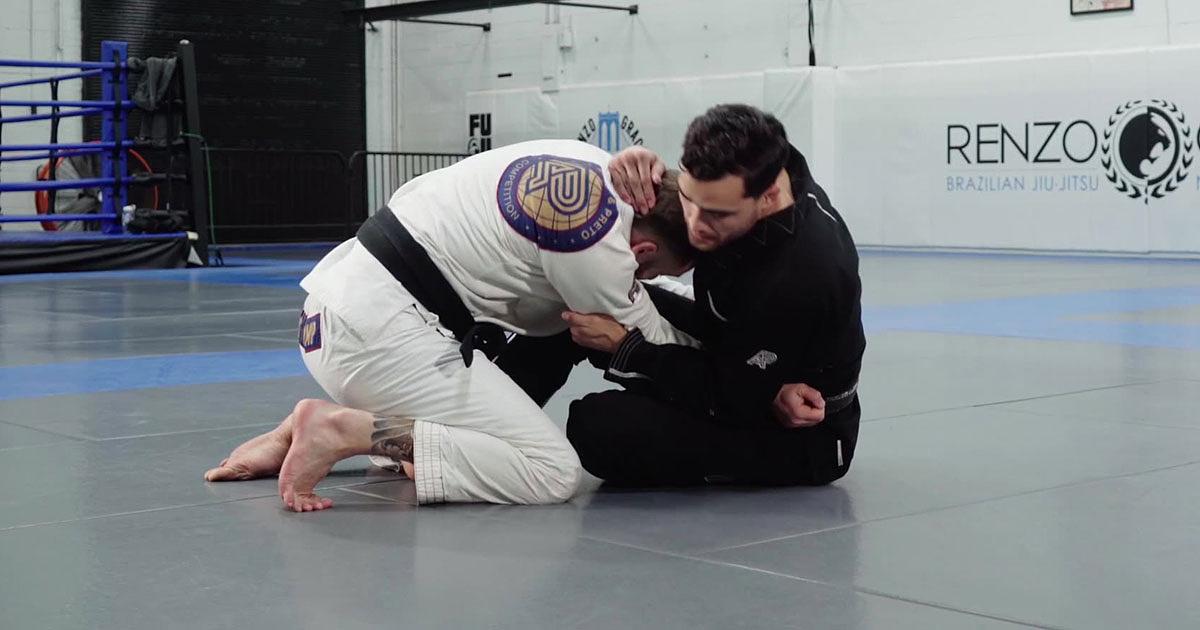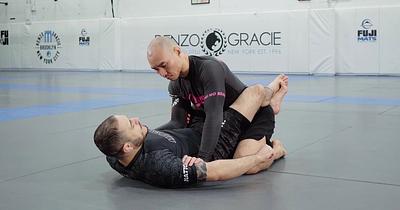Understanding the Butterfly Guard
by Team Digitsu
Updated: March 24, 2025

In the dynamic world of Brazilian Jiu-Jitsu (BJJ), the butterfly guard stands as a fundamental guard position that you’re likely to encounter on the mat. This form of guard utilizes both legs to hook underneath your opponent’s thighs, which allows for a range of sweeps, submissions, and transitions. Adopting the butterfly guard in your BJJ practice offers a robust defense mechanism that can be effective in both gi and no-gi scenarios.
As you train in BJJ, understanding the mechanics of the butterfly guard will enhance your grappling skills immensely. This guard is not just about maintaining control over an opponent; it's also about creating leverage and manipulating their balance to your advantage. Mastery of the butterfly guard can greatly influence your playing style, making you a more versatile and unpredictable martial artist.
Effective use of the butterfly guard requires a blend of timing, technique, and agility. Whether you are a seasoned practitioner or a newcomer to Brazilian Jiu-Jitsu, integrating the butterfly guard into your repertoire is imperative for your development. As you become more comfortable with this position, you’ll find it to be a powerful tool in disrupting your opponent’s posture and setting up a variety of offensive strategies.
Fundamentals of Butterfly Guard
Mastering the Butterfly Guard involves understanding its foundational components and how to maintain a strong position and base. This guard offers control and leverage, allowing you to manage the fight on the ground effectively.
Understanding the Basics
The Butterfly Guard is a ground position in where you sit with your back upright and your legs angled to insert your feet, or 'hooks', under the opponent's thighs. By doing so, you gain the ability to control their movement and balance. Keep in mind that proper control is essential, as it enables you to disrupt your opponent's base and create opportunities for sweeps and submissions.
Positioning and Base
Your base in the Butterfly Guard is crucial for both defense and attack. To establish a solid base:
- Sit with your spine straight, not curved.
- Place your feet strategically inside your opponent’s thighs.
- Distribute your weight evenly between your sit bones.
Your feet must be active, not passive, to engage the muscles necessary for explosive movements. The toes should be digging into the mat, providing the grip needed for mobility and leverage. Remember, your base will determine the effectiveness of your guard, so prioritize maintaining a low center of gravity and being ready to adjust your position as needed.
Essential Techniques in Butterfly Guard
The Butterfly Guard is a dynamic position offering a variety of techniques that you can use to sweep or submit your opponent. Familiarity with these techniques provides you with a strong foundation.
Sweeps and Transitions

There are several key sweeping techniques associated with the Butterfly Guard that you should master. The Butterfly Sweep, also known as Sumi Gaeshi is perhaps the most fundamental and should be part of your arsenal. In executing a butterfly sweep, you will need to obtain an underhook while keeping your other arm as an overhook or on your opponent's belt or pant. Your goal is to use your legs to elevate your opponent and tip them over to the side where you have the underhook.
- Secure the underhook on one side, your overhook or grip on the belt/pant on the other.
- Load your opponent's weight onto your shins.
- Kick your legs while turning to the underhook side to finish the sweep.
Transitions play a crucial role in improving your Butterfly Guard game. By combining different sweep attempts, you can create openings for more advanced sweeps or transition to another potent guard type, like the X-Guard. Remember to always be active with your hooks, and use them to control your opponent’s movement and balance.
Submissions from Butterfly
From the Butterfly Guard, you can also set up a variety of submissions. An effective tactic is to threaten a sweep to compel your opponent to defend in a way that exposes them to a submission. For example, if your opponent posts their arm to prevent a sweep, you can transition to an armbar or a guillotine choke. When your opponent's head is low to prevent a sweep, wrap your arm around their neck and secure the guillotine grip. Capture your opponent's posted arm when resisting a sweep and pivot to isolate and extend the arm.
By combining sweeps with submission threats, you maintain an offensive and unpredictable Butterfly Guard. Practice these techniques to keep your opponent on the defensive and to create opportunities for victory.
Guard Variations and Adaptations
In Brazilian Jiu-Jitsu (BJJ), utilizing guard variations is fundamental for maintaining superior control on the mat. You'll find that knowing how to transition between guards and adapt to your opponent's moves is key to staying one step ahead.
Butterfly Half Guard
The Butterfly Half Guard is a powerful fusion combining elements of the half guard and the butterfly guard. In this position, you typically have one leg entangled with your opponent's (half guard), and the other with a butterfly hook in place. This setup allows for robust sweeping opportunities and fluid transitions:
- Sweeps: Execute by elevating your opponent using the butterfly hook.
- Transitions: Move towards full butterfly guard or into a seated guard depending on your opponent’s reactions and the space available.
Open Guard Transitions
Open Guard Transitions are essential for maintaining offensive and defensive strategies. Your ability to flow from one guard to the next is what can make or break your game when facing a skilled opponent. Let's look at some specifics:
- Side Control to Open Guard: When you find yourself under side control, creating space and framing against your opponent can provide an opening to slip a knee inside and establish an open guard.
- Guard Passes: As your opponent attempts guard passes, utilize open guard transitions to disrupt their base and balance.
- From Half-Guard to Open Guard: You can transition from a half-guard to an open guard by creating separation and maneuvering your legs in front of your opponent.
In your guard game, prioritize fluidity in transitions and adapt your positions to counter your opponent's guard passes and control attempts.
Defensive Strategies
Having a solid defensive strategy is essential. Not only should you aim to prevent sweeps and submissions, but also focus on retaining the butterfly guard to maintain a defensive advantage.
Countering Sweeps and Submissions
In the realm of defense, it's vital to anticipate your opponent's moves and counter them effectively. To thwart butterfly guard sweeps, practicing the sprawl is key. This position lowers your center of gravity, making it harder for the opponent to unbalance you. When your opponent attempts a sweep:
- Post: Place a hand on the mat to maintain balance.
- Sprawl: Drop your hips back to prevent being lifted.
If someone tries to catch you in a submission, like the D'arce Choke, swift movement is your ally. To escape, you need to create space and move your head out of the loop.
- Space Creation: Use your hands to push against your opponent's biceps, creating separation.
- Head Movement: Quickly move your head to the outside of their arms to slip out of the choke.
Retaining Butterfly Guard
Your primary goal in using the butterfly guard is to keep a dominant position. Maintaining back control and securing a potential reversal if the opponent initiates an attack are crucial. To retain the guard:
- Stay active with your hooks, constantly adjusting to your opponent's movements.
- Keep a strong upper body posture to avoid being flattened out.
Utilize grips to control their arms, limiting their ability to execute passes. If they try to pass, a timely hook flip can regain your guard or transition to a more dominant position.
Remember, your defensive strategies in the butterfly guard are not passive; they're an active engagement to secure control and keep yourself safe from attacks.
Offensive Tactics
Having effective offensive tactics can make the difference in gaining the upper hand. Focusing on securing dominant positions and executing high-percentage sweeps are essential for controlling your opponent and advancing in a match.
Securing Dominant Positions
Mount: To gain control, you should prioritize securing the mount, a profoundly dominant position. When in full mount, your hips are positioned above your opponent's, allowing for a range of offensive techniques. Here, you can apply strikes in MMA contexts or set up submissions in BJJ, such as armlocks or chokes. Achieving the mount requires both patience and the use of methodical techniques to bypass your opponent's defenses.
Control: Maintaining control once you secure a dominant position is just as important as getting there. Use your weight distribution and leverage to reduce your opponent's ability to escape or sweep you. Control their hips and shoulders, and work to isolate their arms to increase your submissions options.
Executing High-Percentage Sweeps
Sweeping: High-percentage sweeps require understanding leverage and timing. From the butterfly guard, use your legs to elevate and off-balance your opponent. It's crucial to combine your butterfly hooks with upper body control, like an overhook and an underhook, to effectively sweep your opponent to the mat.
Butterfly Guard to Full Mount: A potent sweep from the butterfly guard is to transition directly into the full mount. As you elevate your opponent with your hooks, use one foot on the ground to generate the necessary leverage for the sweep. This sweeping motion can flip your opponent over, allowing you to slide into the full mount position, giving you significant control and numerous options for submissions.
Building Muscle Memory
Your journey begins with repetition. Consistently practicing the basic movements of the Butterfly Guard, such as hooks and sweeps, cements these techniques in your muscle memory.
- Start with the Basic BJJ Butterfly Lift Drill, focusing on securing your hooks and elevating your opponent.
- Gradually incorporate transitions to other guards and submissions, which root deeper understanding of movement chains in dynamic scenarios.
Gi vs No-Gi Butterfly Guard
In BJJ, the gi is a martial arts uniform that includes a jacket, pants, and a belt, which represents your rank. The gi allows for a variety of grips, such as the collar grip, which are crucial for control in the butterfly guard position.
-
Gi Grips Include:
- Collar
- Sleeve
- Belt
- Pant
No-gi BJJ, on the other hand, resembles more casual athletic wear and limits the available grips. The focus shifts from fabric manipulation to clinching the body and limbs.
-
No-Gi Grips Include:
- Wrist
- Ankle
- Overhooks
- Underhooks


